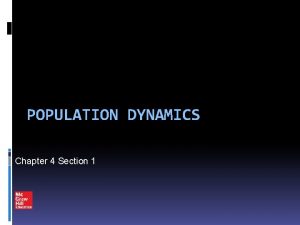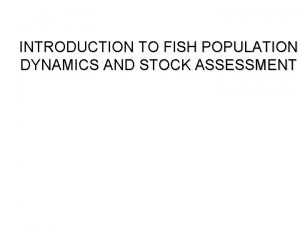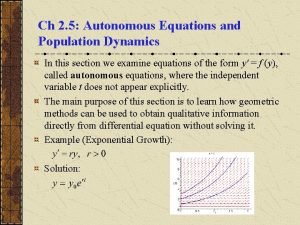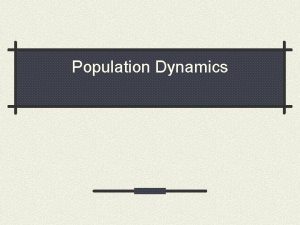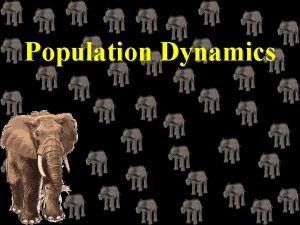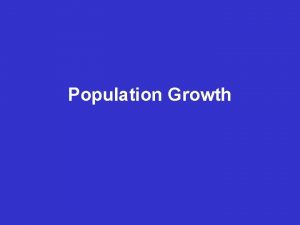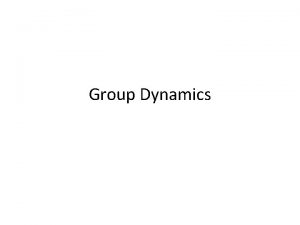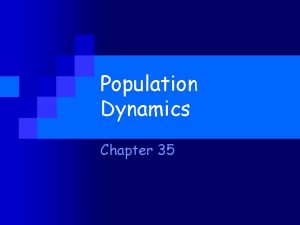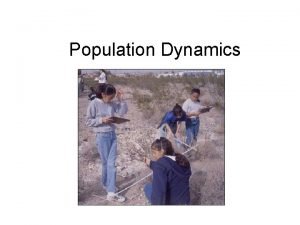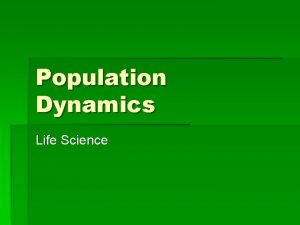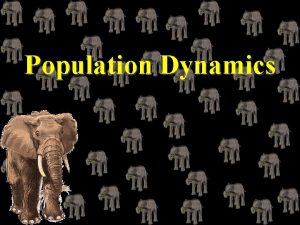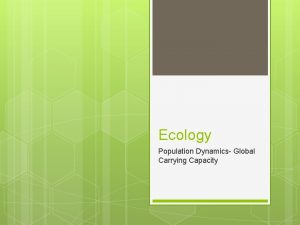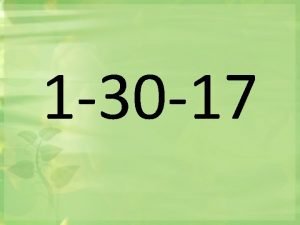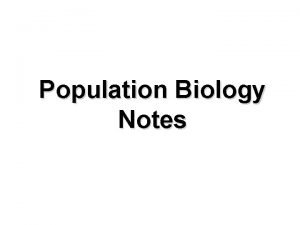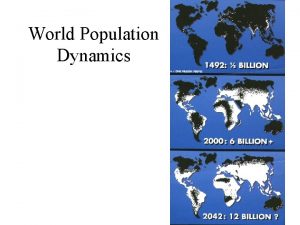Population Dynamics Population Dynamics Population all the individuals































- Slides: 31

Population Dynamics

Population Dynamics Population: all the individuals of a species that live together in an area Demography: the statistical study of populations, make predictions about how a population will change

Counting Populations direct observation-count indirect observation-estimate sampling-count small number in a small area and multiply to get the number in the large area mark and recapture studies-capture, mark, release

mark-recapture method depends on likelihood of recapturing the same individual Figure 35. 2 A

KEY FEATURES OF POPULATIONS 1. Population size n is the number of individuals in a population. n had an important effect on the ability of the population to survive. A small population is more likely to become extinct: n in the case of random events or natural disaster n due to inbreeding where the population is more genetically alike. n with reduced variability it is harder to adapt to changes.

Population Dynamics Three Key Features of Populations • Size • Density • Dispersion • (clumped, even/uniform, random)

Three Key Features of Populations 1. Size: number of individuals in an area

Three Key Features of Populations Growth Rate: Birth Rate (natality) Death Rate (mortality) How many individuals are born vs. how many die Birth rate (b) − death rate (d) = rate of natural increase (r).

POSTREPRODUCTIVE PREREPRODUCTIVE

Population of a Stable Country


Three Key Features of Populations 2. Density: measurement of population per unit area or unit volume Formula: Dp= N S Pop. Density = # of individuals ÷ unit of space

KEY FEATURES OF POPULATIONS, con’t 2. Population density • – the number of individuals in a given area. • – if they are too far apart they may only rarely encounter one another resulting in little reproduction.


4 Factors that affect density 1. Immigration- movement of individuals into a population 2. Emigration- movement of individuals out of a population

4 Factors that affect density 3. Density-dependent factors- Biotic factors in the environment that have an increasing effect as population size increases Ex. disease competition parasites

4 Factors that affect density 4. Density-independent factors. Abiotic factors in the environment that affect populations regardless of their density Ex. temperature storms habitat destruction drought

Factors That Affect Future Population Growth Immigration Natality + + Population Emigration - Mortality

Other factors that affect population growth Limiting factor- any biotic or abiotic factor that restricts the existence of organisms in a specific environment. n EX. - Amount of water Amount of food Temperature

Other factors that affect population growth Carrying Capacity- the maximum population size that can be supported by the available resources There can only be as many organisms as the environmental resources can support

PREDICTING POPULATION GROWTH, con’t Two modes of population growth. The Exponential curve (also known as a Jcurve) occurs when there is no limit to population size. The Logistic curve (also known as an S-curve) shows the effect of a limiting factor (in this case the carrying capacity of the environment).

Carrying Capacity Nu m J-shaped curve (exponential growth) Carrying Capacity (k) b S-shaped curve (logistic growth) e r Time



2 Life History Patterns 1. R Strategists § § § short life span small body size reproduce quickly have many young little parental care Ex: cockroaches, weeds, bacteria

2 Life History Patterns 2. K Strategists § long life span § large body size § reproduce slowly § have few young § provides parental care § Ex: humans, elephants

Human Population Video

Human Population Growth

Human Population Growth

THE HUMAN POPULATION doubled three times in the last three centuries about 7 billion and may reach 9. 3 billion by the year 2050 improved health and technology have lowered death rates

Time unit Births Deaths Natural increase 73, 883, 03 2 Year 130, 013, 274 56, 130, 242 Month Day 10, 834, 440 4, 677, 520 6, 156, 919 356, 201 153, 781 202, 419 6, 408 8, 434 Hour 14, 842 Minute 247 107 141 Second 4. 1 1. 8 2. 3
 Chapter 4 population ecology section 1 population dynamics
Chapter 4 population ecology section 1 population dynamics Section 1 population dynamics
Section 1 population dynamics Population ecology section 1 population dynamics
Population ecology section 1 population dynamics Chapter 4 section 1: population dynamics
Chapter 4 section 1: population dynamics Name 3 points
Name 3 points Whats a density independent factor
Whats a density independent factor Section 1 population dynamics answer key
Section 1 population dynamics answer key Galapagos
Galapagos Fish population dynamics and stock assessment
Fish population dynamics and stock assessment Autonomous equations and population dynamics
Autonomous equations and population dynamics Hình ảnh bộ gõ cơ thể búng tay
Hình ảnh bộ gõ cơ thể búng tay Bổ thể
Bổ thể Tỉ lệ cơ thể trẻ em
Tỉ lệ cơ thể trẻ em Chó sói
Chó sói Tư thế worms-breton
Tư thế worms-breton Hát lên người ơi
Hát lên người ơi Các môn thể thao bắt đầu bằng tiếng đua
Các môn thể thao bắt đầu bằng tiếng đua Thế nào là hệ số cao nhất
Thế nào là hệ số cao nhất Các châu lục và đại dương trên thế giới
Các châu lục và đại dương trên thế giới Công thức tính thế năng
Công thức tính thế năng Trời xanh đây là của chúng ta thể thơ
Trời xanh đây là của chúng ta thể thơ Cách giải mật thư tọa độ
Cách giải mật thư tọa độ Phép trừ bù
Phép trừ bù độ dài liên kết
độ dài liên kết Các châu lục và đại dương trên thế giới
Các châu lục và đại dương trên thế giới Thể thơ truyền thống
Thể thơ truyền thống Quá trình desamine hóa có thể tạo ra
Quá trình desamine hóa có thể tạo ra Một số thể thơ truyền thống
Một số thể thơ truyền thống Cái miệng bé xinh thế chỉ nói điều hay thôi
Cái miệng bé xinh thế chỉ nói điều hay thôi Vẽ hình chiếu vuông góc của vật thể sau
Vẽ hình chiếu vuông góc của vật thể sau Biện pháp chống mỏi cơ
Biện pháp chống mỏi cơ





